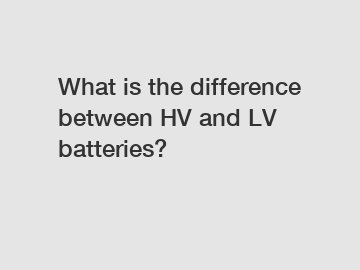What is the difference between HV and LV batteries?
SUNPRO contains other products and information you need, so please check it out.
What is the Difference Between HV and LV Batteries?
Batteries play a crucial role in our daily lives, powering everything from our smartphones to electric vehicles. When it comes to batteries, there are various types and categories available in the market. Two common types are High Voltage (HV) and Low Voltage (LV) batteries. While they might seem similar at first glance, there are significant differences between the two. In this article, we will explore the dissimilarities between HV and LV batteries, and understand their distinct applications.

HV Batteries - Powerhouses of Energy.
HV batteries, as the name suggests, are designed to handle high voltage outputs. These batteries typically operate at voltage levels above 150 volts. They are commonly used in electric vehicles, hybrid vehicles, and grid energy storage systems. HV batteries are known for their ability to store a large amount of energy, making them ideal for applications that require a high power output. They often consist of lithium-ion cells, which have a high energy density and can provide long-lasting power. HV batteries are capable of delivering more power to devices or vehicles, making them suitable for demanding applications.
LV Batteries - A Lower Voltage Alternative.
On the other hand, LV batteries are designed to operate at lower voltage levels, usually below 150 volts. These batteries are commonly found in devices like laptops, smartphones, and other portable electronic devices. LV batteries are typically lighter and smaller than HV batteries, as they do not need to handle high power output requirements. They can be easily charged and discharged, providing a convenient power source for everyday devices. LV batteries are often composed of lithium-ion or nickel-cadmium cells, offering a reliable power supply for low-power applications.
Applications of HV and LV Batteries.
HV batteries are primarily used in electric vehicles and hybrid vehicles. Due to their high energy storage capabilities, HV batteries provide the required power to run these vehicles efficiently. Moreover, HV batteries are increasingly employed in grid energy storage systems to store excess energy during off-peak hours and supply it back during peak demand. This helps balance the load on the electrical grid and promotes the utilization of renewable energy sources.
On the other hand, LV batteries find applications in a vast range of portable electronic devices, such as smartphones, laptops, tablets, and digital cameras. These batteries offer a reliable power source for low-power devices, ensuring they can function seamlessly throughout the day. Additionally, LV batteries are also found in uninterruptible power supply systems (UPS), providing backup power in case of power outages or fluctuations.
Conclusion.
In conclusion, the key difference between HV and LV batteries lies in their voltage levels and applications. HV batteries are designed to handle high voltage outputs and are commonly used in electric vehicles and grid energy storage systems. These batteries provide a high power output and enable the efficient functioning of energy-intensive applications. On the other hand, LV batteries operate at lower voltage levels and are typically found in portable electronic devices. They offer a convenient power source for low-power applications and ensure uninterrupted usage of everyday devices.
If you need further assistance or have any questions regarding HV or LV batteries, please feel free to contact us.
For more information, please visit lifepo4 3.2 v 300ah.



